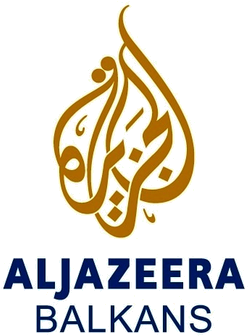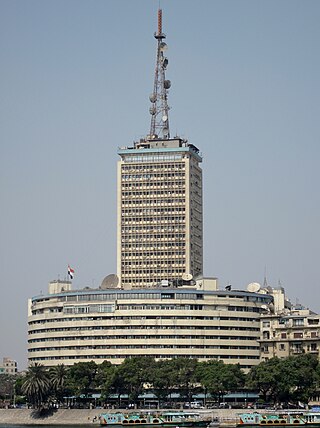Egypt has long been the cultural and informational centre of the Middle East and North Africa, and Cairo is the region's largest publishing and broadcasting centre.
Telecommunications in Sudan includes fixed and mobile telephones, the Internet, radio, and television. Approximately 12 million out of 45 million people in Sudan use the Internet, mainly on smartphones and mobile computers.

Iraq was home to the first television station in the Middle East, which began during the 1950s. As part of a plan to help Iraq modernize, English telecommunications company Pye Limited built and commissioned a television broadcast station in the capital city of Baghdad. Following the 2003 US-led invasion of Iraq, the Iraqi state media collapsed. In June 2004, a Communications and Media Commission was set up to approve and grant license for all the country's media. By 2011, Iraq was the headquarters of 49 free-to-air satellite channels, one of the highest numbers in the region. Until 2003, satellite dishes were banned in Iraq, and there was a limited number of national terrestrial stations. After 2003, the sale of satellite dishes surged, and free-to-air channels entered the market. There are 17 terrestrial channels, of which one is funded by the US government through the U.S. Agency for Global Media (Alhurra-Iraq), and seven are owned by the state broadcaster Iraqi Media Network. In March 2011, Al Jazeera was granted rights to resume operations after being banned in 2004. Plans were established to set up a free-media zone based in Baghdad, the Baghdad Media City, by the end of 2014.

Al Arabiya is a Saudi state-owned international Arabic news television channel. It is based in Riyadh and is a subsidiary of MBC Group.

Al Jazeera English is a 24-hour English-language news channel. It operates under the ownership of the Al Jazeera Media Network, which is funded in part by the government of Qatar. In a bid to broaden its reach, Al Jazeera introduced an English-language division in 2006. It is the first global English-language news channel to be headquartered in the Middle East.
As of the early 2000s, Sudan had one of the most restrictive media environments in Africa. Sudan's print media since independence generally have served one of the political parties or the government in power, although there occasionally were outspoken independent newspapers.
Television in Lebanon arose as a private initiative and not a state-institution. Lebanon was the first country in the Middle East & the Arab world to have indigenous television broadcasting. Various Arab televisions emulated the Lebanese model.
Satellite television varies in the different regions around the world.

Al Jazeera Media Network is a private-media conglomerate headquartered at Wadi Al Sail, Doha, funded in part by the government of Qatar. The network's flagship channels include Al Jazeera Arabic and Al Jazeera English, which provide coverage of regional and international news, along with analysis, documentaries, and talk shows. In addition to its television channels, Al Jazeera has expanded its digital presence with platforms such as AJ+, catering to younger audiences with formats and content tailored for online consumption. Al Jazeera broadcasts in over 150 countries and territories, and has a large global audience of over 430 million people.
Local television is the most significant media platform in Yemen. Given the low literacy rate in the country, television is the main source of news for Yemenis. There are six free-to-air channels currently headquartered in Yemen, of which four are state-owned.
The mass media in South Sudan is underdeveloped compared to many other countries, including fellow East African states like Kenya, Tanzania, and Uganda. Poor transportation infrastructure and entrenched poverty in the country inhibit both the circulation of newspapers, particularly in states located far from the capital of Juba, and the ability of media outlets to maintain regular coverage of the entire country.

Al Jazeera Balkans (AJB) is an international news television station headquartered in Sarajevo, Bosnia and Herzegovina aimed at the media markets of the countries that used to be constituent units of SFR Yugoslavia. It is part of the Al Jazeera Media Network.
Television in Saudi Arabia was introduced in 1965, but is now dominated by just five major companies: Middle East Broadcasting Center, SM Enterprise TV, Lebanese Broadcasting Corporation, Rotana and Saudi TV. Together, they control 80% of the pan-Arab broadcasting market. Saudi Arabia is a major market for pan-Arab satellite and pay-TV. Saudi investors are behind the major networks MBC, which is based in Dubai, and Emirates based OSN. The Saudi government estimated that in 2000 the average Saudi spent 50% to 100% more time watching television than his or her European or US counterpart. On average, 2.7 hours are spent daily watching TV in Saudi Arabia.
In Bahrain, there are seven free-to-air television channels, four of which are privately owned. The country's public service broadcaster, Bahrain Radio and Television Corporation (BRTC), broadcasts over five terrestrial TV networks, including the popular Channel 44. Around 35–40% of its output is locally produced. Free satellite is the dominant television platform, reaching 51% of Bahraini households. The country has a relatively high pay-TV penetration, estimated at 51% in 2011. There are three main pay-TV operators: OSN, ART and Al Jazeera Sports. The government-controlled Information Affairs Authority directly controls BRTC and indirectly controls the country's other television networks.

Television in Egypt is mainly received through free satellite, while analog terrestrial represents 41% of total viewers. The Central Agency for Public Mobilisation and Statistics (CAPMAS) said the average time an Egyptian spends watching television a day is 180 minutes, while Egyptian channels recorded 170,000 hours of broadcast in 2019.
Television in Jordan is dominated by pan-Arab satellite, with terrestrial accounting for 16% of TV households in the country. There are 29 free-to-air satellite channels headquartered in Jordan. Pay-TV penetration is low, estimated at 4% in 2011.
Television in Qatar is very much state-influenced and operated. Official Qatar TV began producing and transmitting its own programmes in 1970, with colour transmission since 1974. It had a monopoly on television audience until 1993, when Qatar Cablevision began broadcasting satellite channels. Since then, four other platforms went on air: ART/1st NET, Orbit, Star Select and Gulf DTH/Showtime. Despite the broadening of television offerings, Qatar TV remains popular among Qataris.
Television in Libya has a penetration estimated at 76% for 2011.

The mass media in Qatar relays information and data in Qatar by means of television, radio, cinema, newspapers, magazines and the internet. Qatar has established itself as a leading regional figure in mass media over the past decade. Al Jazeera, a global news network which was established in 1996, has become the foundation of the media sector. The country uses media to brand itself and raise its international profile.
Al Jazeera Arabic is a Qatari state-owned Arabic-language news television network. It is based in Doha and operated by the Al Jazeera Media Network, which also operates Al Jazeera English. It is the largest news network in the Middle East and North Africa region. It was founded in 1996 by the then Emir of Qatar Sheikh Hamad bin Khalifa Al Thani.







